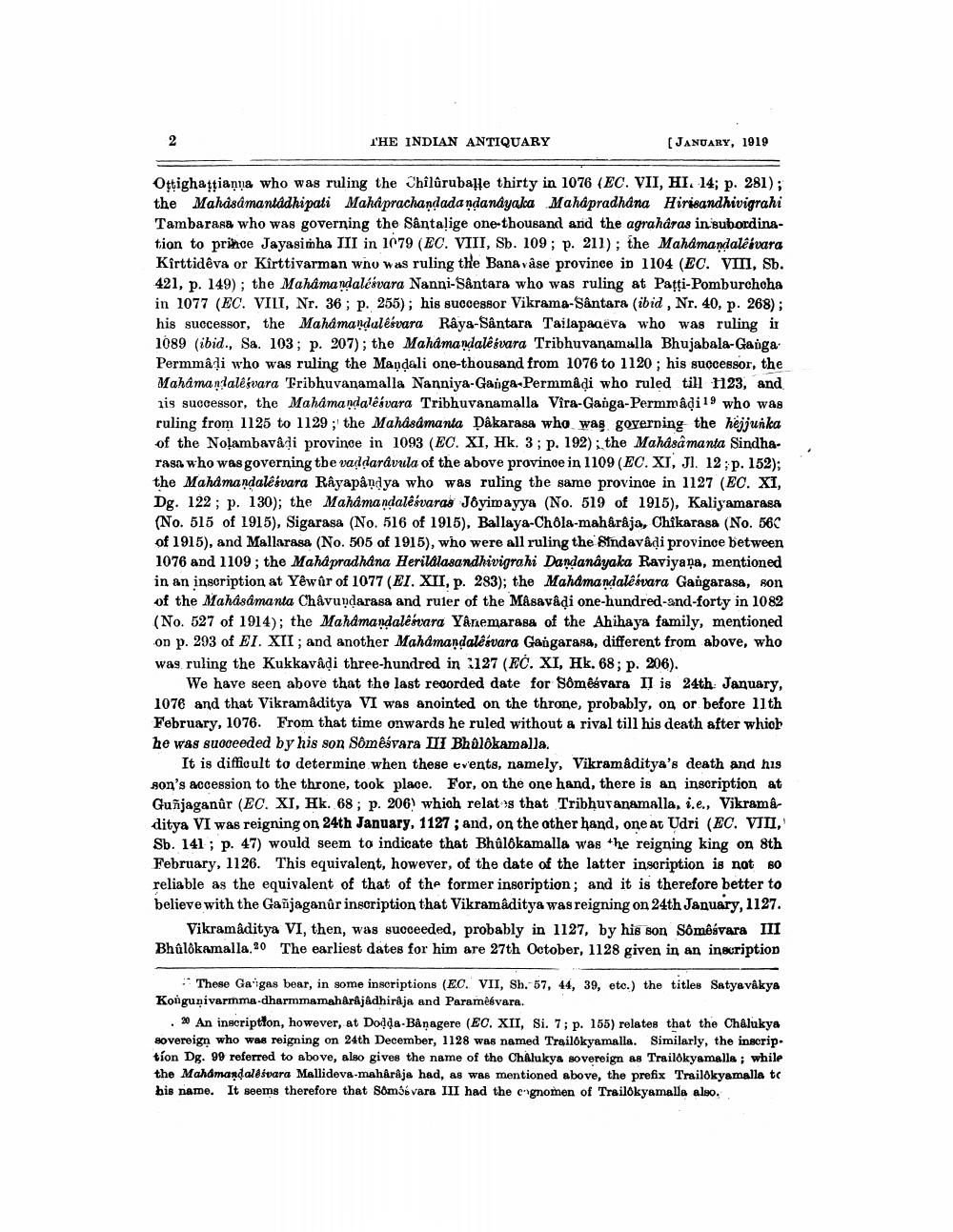Book Title: Indian Antiquary Vol 48 Author(s): Richard Carnac Temple, Devadatta Ramkrishna Bhandarkar Publisher: Swati Publications View full book textPage 6
________________ 2 THE INDIAN ANTIQUARY [ JANUARY, 1919 Ottighattianna who was ruling the Chilûruballe thirty in 1076 (EC. VII, HI. 14; p. 281); the Mahasamantadhipati Mahaprachandadandanayaka Mahapradhana Hirisandhivigrahi Tambarasa who was governing the Sântalige one-thousand and the agraharas in subordination to prince Jayasimha III in 1079 (EC. VIII, Sb. 109; p. 211); the Mahamandale ivara Kirttidêva or Kîrttivarman who was ruling the Bana vâse province in 1104 (EC. VIII, Sb. 421, p. 149); the Mahamandalésvara Nanni-Sântara who was ruling at Patti-Pomburchcha in 1077 (EC. VIII, Nr. 36; p. 255); his successor Vikrama-Sântara (ibid, Nr. 40, p. 268); his successor, the Mahamandalêsvara Râya-Sântara Tailapaaeva who was ruling in 1089 (ibid., Sa. 103; p. 207); the Mahamandalêsvara Tribhuvanamalla Bhujabala-Ganga Permmâḍi who was ruling the Mandali one-thousand from 1076 to 1120; his successor, the Mahamandalêsvara Tribhuvanamalla Nanniya-Ganga-Permmâḍi who ruled till 1123, and is successor, the Mahamandalêsvara Tribhuvanamalla Vira-Ganga-Permmâḍi 19 who was ruling from 1125 to 1129; the Mahasamanta Dâkarasa who was governing the hejjunka of the Nolambavâdi province in 1093 (EC. XI, Hk. 3; p. 192); the Mahasamanta Sindharasa who was governing the vaḍdarâvula of the above province in 1109 (EC. XI, JI. 12; p. 152); the Mahamandalesvara Râyapândya who was ruling the same province in 1127 (EC. XI, Dg. 122; p. 130); the Mahamandalêsvaras Jôyimayya (No. 519 of 1915), Kaliyamarasa (No. 515 of 1915), Sigarasa (No. 516 of 1915), Ballaya-Chôla-mahârâja, Chîkarasa (No. 56C of 1915), and Mallarasa (No. 505 of 1915), who were all ruling the Sindavadi province between 1076 and 1109; the Mahapradhana Herilalasandhivigrahi Dandanayaka Raviyana, mentioned in an inscription at Yêwûr of 1077 (EI. XII, p. 283); the Mahamandalêsvara Gangarasa, son of the Mahasamanta Châvundarasa and ruler of the Mâsavâḍi one-hundred-and-forty in 1082 (No. 527 of 1914); the Mahamandalêsvara Yânemarasa of the Ahihaya family, mentioned on p. 293 of EI. XII; and another Mahamandalêsvara Gangarasa, different from above, who was ruling the Kukkavâḍi three-hundred in 127 (EĆ. XI, Hk. 68; p. 206). We have seen above that the last recorded date for Sômêsvara II is 24th January, 1076 and that Vikramaditya VI was anointed on the throne, probably, on or before 11th February, 1076. From that time onwards he ruled without a rival till his death after which he was succeeded by his son Sômêsvara III Bhûlôkamalla. It is difficult to determine when these events, namely, Vikramaditya's death and his son's accession to the throne, took place. For, on the one hand, there is an inscription at Guñjaganûr (EC. XI, Hk. 68; p. 206) which relates that Tribhuvanamalla, i.e., Vikramâditya VI was reigning on 24th January, 1127; and, on the other hand, one at Udri (EC. VIII,' Sb. 141; p. 47) would seem to indicate that Bhûlôkamalla was the reigning king on 8th February, 1126. This equivalent, however, of the date of the latter inscription is not so reliable as the equivalent of that of the former inscription; and it is therefore better to believe with the Gañjaganûr inscription that Vikramaditya was reigning on 24th January, 1127. Vikramaditya VI, then, was succeeded, probably in 1127, by his son Sômêsvara III Bhûlôkamalla. 20 The earliest dates for him are 27th October, 1128 given in an inscription These Gaigas bear, in some inscriptions (EC. VII, Sh. 57, 44, 39, etc.) the titles Satyavakya Kongunivarmma-dharmmamahârâjâdhiraja and Paramêévara. 20 An inscription, however, at Dodda-Bânagere (EC. XII, Si. 7; p. 155) relates that the Chalukya sovereign who was reigning on 24th December, 1128 was named Trailôkyamalla. Similarly, the inscrip. tíon Dg. 99 referred to above, also gives the name of the Chalukya sovereign as Trailôkyamalla; while the Mahamandalêsvara Mallideva-mahârâja had, as was mentioned above, the prefix Trailôkyamalla t his name. It seems therefore that Somos vara III had the cognomen of Trailökyamalla also.Page Navigation
1 ... 4 5 6 7 8 9 10 11 12 13 14 15 16 17 18 19 20 21 22 23 24 25 26 27 28 29 30 31 32 33 34 35 36 37 38 39 40 41 42 43 44 45 46 47 48 49 50 51 52 53 54 55 56 57 58 59 60 61 62 ... 458
